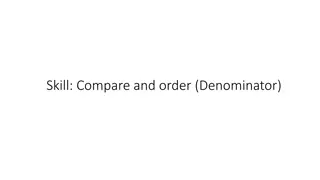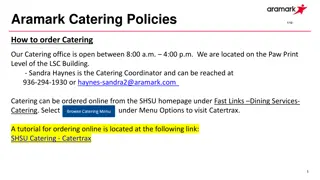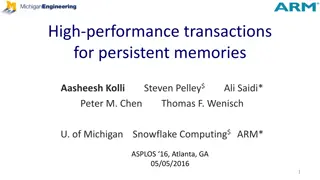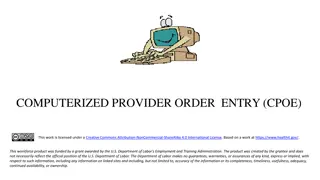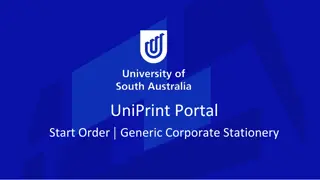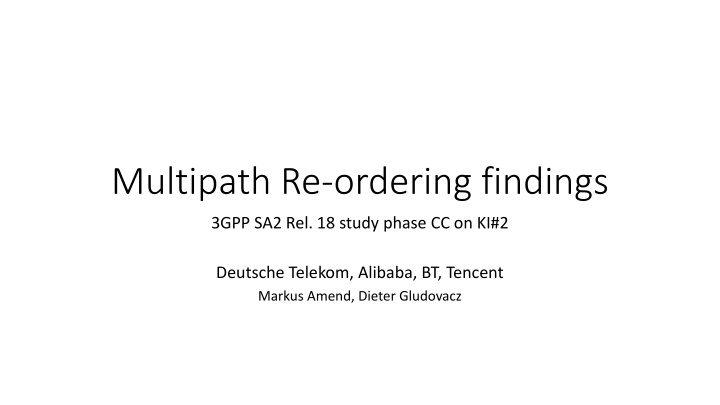
Improving Multipath Performance through Re-ordering for 3GPP SA2 Rel-18 Study
Enhance network throughput by addressing issues of jitter and out-of-order delivery in multipath scenarios. Diagnose the need for re-ordering, explore solutions for traffic splitting challenges, and discuss the importance of specifying re-ordering in the 3GPP standard to ensure robust performance. Find out why leaving re-ordering to implementation may lead to inconsistent results and why MP-QUIC streams might not be the best solution. Discover how re-ordering can overcome issues in disjoint path propagation and improve performance beyond single-path transmission.
Download Presentation

Please find below an Image/Link to download the presentation.
The content on the website is provided AS IS for your information and personal use only. It may not be sold, licensed, or shared on other websites without obtaining consent from the author. If you encounter any issues during the download, it is possible that the publisher has removed the file from their server.
You are allowed to download the files provided on this website for personal or commercial use, subject to the condition that they are used lawfully. All files are the property of their respective owners.
The content on the website is provided AS IS for your information and personal use only. It may not be sold, licensed, or shared on other websites without obtaining consent from the author.
E N D
Presentation Transcript
Multipath Re-ordering findings 3GPP SA2 Rel. 18 study phase CC on KI#2 Deutsche Telekom, Alibaba, BT, Tencent Markus Amend, Dieter Gludovacz
KI#2 solution Goal: Enhanced throughput with traffic splitting beyond single-path Challenge: Splitting introduces significant Jitter and Out-of-order Observation: Today services struggle with high Jitter and Out-of-order Solution: Re-ordering and path latency difference compensation Side-effect: Duplicate packet filtering for KI#3 30.06.2022 2
Why is re-ordering needed? Access propagation difference can be expected in the order of several tens of milliseconds. Therefore, disjoint path propagation introduces - huge amount of out-of-order delivery and - significant jitter not comparable with today s single path transmission. Problem: E2E QUIC based services are sensitive to out-of-order generated duplicate ACKs, like TCP, and reduce throughput. Problem: E2E QUIC using latency sensitive Congestion Control, e.g. BRR as used in Google s universe, reduce performance when jitter is experienced. Measurement w/o re-ordering TCP E2E QUIC E2E Re-ordering overcomes disjoint path characteristics and provides performance beyond single path 30.06.2022 3
Can Re-ordering be left to implementation? Different implementations can be expected in UE and UPF no implementation to support of partial or very comprehensive re-ordering May not be activated or de-activated Inconsistent implementations in UE and UPF might lead to worse performance than single-path different Up- and Downlink experience Minimum requirement to be supported by each implementation Measurement w/ partial re-ordering BBR E2E 30.06.2022 4
Why MP-QUIC stream is not a good idea? Imposes strict reliability with re-transmission and strict in-order delivery to E2E traffic Dominant future user traffic expected to be HTTP3/QUIC, i.a. strict reliability and in-order. Problem 1: Nested reliability with re-transmission and in-order delivery Problem 2: No solution for latency variance due to path latency difference Measurements conducted by MPTCP enthusiasts have shown very bad performance tunneling QUIC over MPTCP. From the characteristic, this is effectively the same as QUIC over MP-QUIC in stream mode. Phenonema is well known and denoted as TCP Meltdown 30.06.2022 5
Why specifying re-ordering in 3GPP? Ensure KI#2 performance better than single-path for any traffic which is not known to be re-ordering robust. Proposal 1: ATSSS Phase 3 to provide a solution for a switch to activate or de-activate re-ordering in the context of a MA-PDU session 30.06.2022 6
How specifying re-ordering in 3GPP? Implement one mechanism which is known to deliver best performance across any traffic types Proposal 2: ATSSS Phase 3 to specify one re-ordering including path latency difference compensation Measurement Use re-ordering sequencing for duplicate packet detection and filtering Proposal 3: Consider re-ordering for redundant steering mode KI#3. 30.06.2022 7
Backup 30.06.2022 8
Why Reordering is not provided by IETF? IETF doesn t show any activity to treat re-ordering in scope of any of the MP-protocol developments. In that it follows the pure focus on the protocol design and doesn t care about traffic distribution or re-assembly. For that reason 3GPP had to define steering modes on top of MP protocol. The only known document on re-ordering is located as informational research document from an individual in IRTF. Even if work would start today at IETF no meaningful output can be expected within Rel. 18 time frame. 30.06.2022 9
General observations shared in S2-2203965 Observation 1: Latency/Jitter and Out of order packet delivery are even bigger challenges in multi-path than in single path scenarios. Observation 2: TCP's and QUIC's reliable and in-order delivery transport characteristic is ensured by flow and congestion control with specific demand on latency/jitter and order of delivery. Observation 3: There exists UDP traffic which does not need flow and/or congestion control at all or with lower quality demand on latency/jitter and order of delivery. Observation 4: Non-TCP traffic mix ranges between UDP and TCP-like requirements with different demands on in-order delivery and stable latency. Observation 5: All solutions discussed for non-TCP traffic splitting must cope with this broad range of transport requirements. Observation 6: At the last SA2#150e meeting it was widely acknowledged, that re-ordering is a necessity. Observation 7: Re-ordering for MP-DCCP or MP-QUIC is not on the roadmap of IETF. Observation 8: MPTCP or MP-QUIC (without DATAGRAM) as such are not suitable for in-order delivery for non-TCP traffic. Observation 9: Test results show re-ordering can greatly improve the performance/throughput of reliable flows (e.g. QUIC traffic) with strict in order requirement. Observation 10: For services without sensitivity to reliability and order of delivery work well without re-ordering, otherwise re-ordering is needed. 30.06.2022 10
Back Measurement w/o re-ordering carrying TCP Packets entering the ATSSS receiver are forwarded in the order they arrive. Setup: Priority based steering mode with preference on low-latency path, Path delay difference 15ms, 10Mbps both links Note: Average goodput measured by iPerf = 12.0 Mbits/sec and indicates, as per the measurement diagram, that throughput is wasted for unnecessary re-transmissions. Out-of-order data reception causes Duplicate Acknowledgements (DupACKs) in TCP, which TCP s congestion control (CC) interprets as error prone transmission. Consequently, the CC reduces the send window to avoid overflowing into the secondary path, impacting the total achievable throughput adversely. 30.06.2022 11
Back Measurement w/o re-ordering carrying QUIC Packets entering the ATSSS receiver are forwarded in the order they arrive. Setup: Priority based steering mode with preference on low-latency path, Path delay difference 15ms, 10Mbps both links Similar to TCP s DupACK strategy, RFC9000 (QUIC) specifies a similar mechanism which causes the quic-go implemented congestion control to assume packet loss. This prevents the bundling of the secondary path (green) with the higher latency and the primary path (purple) is used almost exclusively. The end-to-end stream (blue) is limited therefore by the primary path capabilities. (Note: the primary link throughput is greater than the end-to- end stream due to the tunnel overhead) 30.06.2022 12
Back Measurement w/ partial re-ordering carrying latency sensitive BBR Setup: Priority based steering mode with preference on low-latency path, Path delay difference variable, 10Mbps both links, Expiration timer value 50ms Packet loss introduced in the primary path: 1% Fast packet loss detection exploits path and connection sequencing to detect packet loss much earlier than when the packet loss detection timer expires. Most latency spikes caused by the expiration of the timer are avoided and provides therefore a more stable end-to-end latency. This further helps the carried service to detect earlier the packet loss in its receiver and request re-transmission from its sender. In case no fast packet loss detection is available, a latency sensitive TCP BBR stream is not able to achieve aggregation and even worse, falls below the single path capabilities (<10 Mbps). With fast packet loss enabled, the end-to-end latency is more stabilized when the expiration of the static timer can be avoided and leads therefore to an aggregation benefit. 30.06.2022 13
Back Measurement w/ re-ordering and path latency compensation Setup: Priority based steering mode with preference on low-latency path, Path delay difference 15ms, 10Mbps both links, Dynamic expiration timer, Path latency difference compensation Multi-path characteristic close to singlepath characteristic is the right mean to provide aggregated througput performance. This is achieved due to re-ordering and path latency difference compensation. 30.06.2022 14









